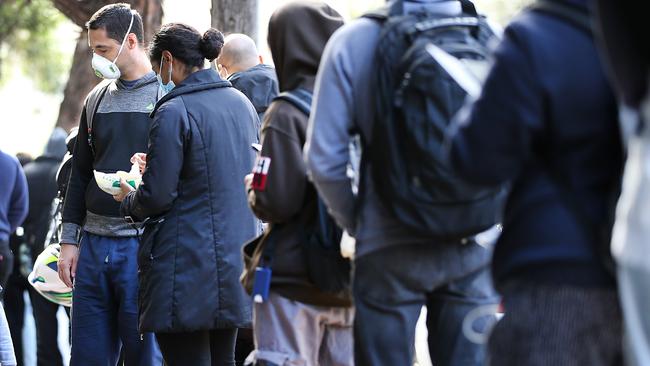
The puzzle is that nearly one in every five people in the workforce are – more accurately, were, when the measurements were done in October – either unemployed or underemployed.
Yet job ads are at record levels and employers are desperate for workers, especially in hospitality and for spring harvesting. They always are, with the latter of course.
How can we have both a surplus of workers, and a pretty huge one at around 18 per cent of the workforce – unemployed and underemployed – and a pressing shortage, even if just a sectoral shortage, of workers at the same time?
An extension of the puzzle is that one way it is not playing out – again, at least, so far – is in rapidly accelerating wages, as we’ve seen in both the US and across the Tasman.
Now there is both an easy explanation for the seeming contradiction and an equally seemingly easy way to resolve it: for two years we haven’t had the foreign students, backpackers and other work-visa holders to fill those jobs.
That was fine, or rather not evident, when we were in lockdown. Now that we are out and hoping to stay out, by the grace of God, Gaia and the vaccines, surely the shortage at least will self-resolve if not the broader worker surplus side of the puzzle?
When they come back, we might still have high jobless and underemployment rates, but at least businesses will get their workers; and their spending in turn will generate activity and jobs which should soak up some of the ranks of the generalised jobless/underemployed, thereby boosting wage levels.
This thinking suggests we have no option: we have to go back to the broad “people mix” that we had until March 2020: that mix of migrants, students, backpackers, and temporary work-visa holders.
The second level of this discussion then becomes how many. I would suggest that 400k a year suggested or indeed seemingly demanded by NSW bureaucrats might reasonably be taken as the “upper bound”, with something around 100k as the “lower”, subject to practical Covid realities, even in a vaccinated world, if nothing else.
The surplus shows in the latest ABS data for October, with the jobless rate surging to 5.2 per cent. A further 9.5 per cent were underemployed, making 14.7 per cent for the total.
Now the key thing to understand is that the survey was done in the first two weeks of October, when both Victoria and NSW – and so 55 per cent of the national labour market – were still in lockdown.
So, this means that the real or post-lockdown jobless numbers would actually be much better, thereby partially explaining that seeming puzzle between labour shortage and surplus?
Yes, but also no. The “no” part is that the “real” ABS jobless numbers were actually much higher, at least as they were in early October; and when adjusted for that, they were actually very close to the much higher Roy Morgan numbers.
In the weird world created by Covid-19 and even more government responses to it, the ABS has been counting as “employed”, and so excluded from the “jobless” numbers, people who worked zero hours for economic reasons and a second cohort of people who worked zero hours for “other” reasons.
It is an interesting construct: the idea that you can be employed to work zero hours. But heck, everything’s crazy there days, so why not statistical definitions.
These are essentially workers who have been stood down and/or opted out around lockdowns and payments of JobKeeper Version 2.3 (the sort of enhanced JobSeeker).
Add them back to the ABS numbers and you get a real jobless rate more like 7-8 per cent and a total jobless and underemployment rate closer to 17 per cent – not far short of Morgan’s 17.8 per cent.
That’s a labour surplus, if ever there’s one.
But the “yes” part is that it will have fallen sharply after Victoria and NSW came out of lockdown; and it will continue to fall sharply as we ride through the mini-spending boom leading up to Christmas; critically in the absence of all those foreign workers.
This will lead to a big test of the expectation of still modest generalised wages growth. Then we hit whatever January brings, including whether it brings the start of a sustained flood of foreign workers.
If those workers don’t come, for whatever reason, we will see surging wages and inflation. But even if they do come, whether surging or dribbling, we are likely to still see higher inflation and some wages growth anyway.
The December quarter CPI, which surfaces in late January, just ahead of the RBA’s first meeting for the year in early February, will be extraordinarily important.
The RBA of course accepted reality in short-term bond pricing at its Melbourne Cup meeting. It won’t be doing anything further at its December meeting; in part because of that surge in short bond yields.
A surge, which is already flowing through into increases in bank fixed-term housing loan rates, could very well see a rise in bank variable rates early in the new year, quite apart from anything the RBA doles with its official rate.
It is very likely we will get a “shock” December-quarter inflation figure; as the inflation that has surfaced everywhere else driven by higher energy prices and supply chain disruptions finally “arrives” in Australia, or at least into Australian data.
That makes for a potentially (very) “interesting” cocktail early next year of the wage surplus evaporating seemingly overnight in the context of seemingly suddenly higher inflation.
Hmm: then add Wall Street and the Fed.




The great puzzle right now in Australia is centred on jobs. How it is resolved as we head into 2022 will be the critical driver of so much that happens – wages, inflation, interest rates, and not least the outcome of the looming federal election.